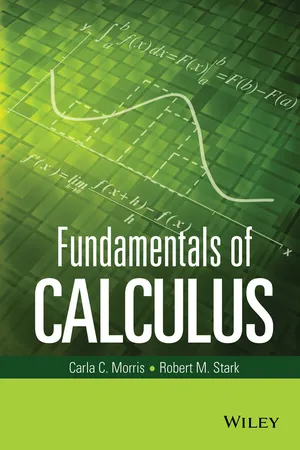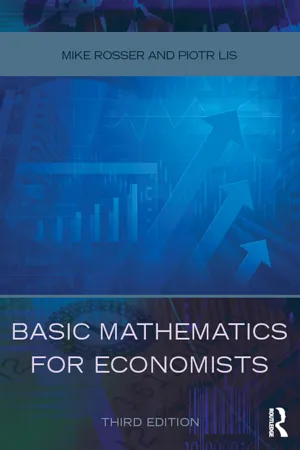Mathematics
Graphs of Exponents and Logarithms
Graphs of exponents and logarithms show the relationship between the base and the exponent or logarithm. Exponential graphs typically have a curved shape, while logarithmic graphs are characterized by a curve that approaches but never touches the x-axis. These graphs are useful for visualizing and understanding the behavior of exponential and logarithmic functions.
Written by Perlego with AI-assistance
Related key terms
Related key terms
1 of 4
Related key terms
1 of 3
7 Key excerpts on "Graphs of Exponents and Logarithms"
- eBook - ePub
Finite Mathematics
Models and Applications
- Carla C. Morris, Robert M. Stark(Authors)
- 2015(Publication Date)
- Wiley(Publisher)
Their domain is the real numbers, while their range is the positive real numbers. There is no x -intercept and the y -intercept is at. There is a horizontal asymptote at (the x -axis). When the base is between 0 and 1 the function is decreasing, and when the base exceeds 1, the function is increasing. The graph of the exponential functions and shows these properties. Recall that the transcendental number e is approximately 2.718. The special exponential function has the characteristics discussed. For the graph of : the domain is all real numbers; the range is positive real numbers; the x -axis is an asymptote; the y -intercept is 1; there is no x -intercept; it is an increasing function. The Laws of Exponents apply to the transcendental number e, as Example 1.5.3 illustrates. Example 1.5.3 Simplifying Exponential Exponents Simplify a. b. c. Solution: a. Multiplying the exponents yields. b. Subtracting the exponents yields. c. Rewrite as. Logarithmic Functions L ogarithmic functions are inverses of exponential functions. The following formulas convert logarithmic into exponential forms and vice versa. Logarithmic and Exponential Forms means and vice versa. ♦ John Napier discovered logarithms in the latter part of the sixteenth century. Logarithms are useful for constructing mathematical models and for solving equations with exponential functions. Any logarithm can be expressed as an exponential and vice versa. For instance, to graph it is expressed equivalently as as shown: While the domain for logarithms is, the range is all real numbers. The x -intercept of a logarithmic function is 1, while the y -intercept does not exist. Example 1.5.4 Exponential and Logarithmic Forms Express exponential forms in logarithmic forms and vice versa. (a) Solution: The equivalent logarithmic forms are: a. b. The equivalent exponential forms are: Most calculators have two logarithm keys: log x and ln x. The first is for base and the second is for base e - eBook - ePub
- Carla C. Morris, Robert M. Stark(Authors)
- 2015(Publication Date)
- Wiley(Publisher)
The function increases when the base exceeds unity. The graphs of the exponential functions and illustrate these properties.. The transcendental number,, is an important base for the exponential function. The domain of is the real numbers, the range is the positive real numbers, the x -axis is an asymptote, and the y -intercept is unity. There is no x -intercept. Finally, is an increasing function as shown.. Example 4.1.3 Simplifying Exponents Involving e x Simplify the following: Solution: Removing parenthesis and multiplying the exponents yields. Subtracting exponents yields. Rewrite as. Exercises 4.1 In Exercises 1–6, rewrite the expressions with bases or. In Exercises 7–12, simplify the expressions using the laws of exponents. 7. 8. 9. 10. 11. 12. In Exercises 13–20, solve for x. 13. 14. 15. 16. 17. 18. 19. 20. In Exercises 21–25, the expressions can be factored. Find the missing factor. 21. 22. 23. 24. 25. 4.2 Logarithmic Functions Logarithmic functions are inverses of exponential functions and conversely! The relationship between logarithms and exponentials is: Logarithms and Exponentials implies and conversely Any logarithm can be expressed as an exponential and vice versa. For instance, can be expressed as. This format is convenient to determine the ordered pairs for the following graph.. While the domain for x is, the range for y is all real numbers. The x -intercept is at. There is no y -intercept. Example 4.2.1 Exponential and Logarithmic Forms Convert exponentials to logarithms or vice versa. Solution: The exponential is converted to the logarithm. The exponential is converted to the logarithm. The logarithm is converted to the exponential. The logarithm is converted to the exponential. Most calculators have two logarithmic keys: log x and ln x. The log x has a base and ln x has a base e. Base 10 logarithms are called common logarithms, while base e logarithms are called natural logarithms - eBook - ePub
- Mike Aitken, Bill Broadhurst, Stephen Hladky(Authors)
- 2009(Publication Date)
- Garland Science(Publisher)
nth root’ – allows us to use this relation in describing our science even before we put in specific values. That is what the use of algebra in science is all about.3.6 Exponentials and logsRaising to a power is a function of the base when the exponent is constant. However, raising to a power can be looked at differently. When the base a, which should be positive, is held constant and the exponent is varied, raising a to the power x, y = ax , is called the exponential function with base a. Both a and x must be numbers, not physical quantities. So far, there is nothing new. The procedures we have already described allow us to calculate exponentials just as they allow us to raise a base to a power. However, there is a change in emphasis focusing now on the exponent rather than the base. It is now very important to remember that the exponent can be any real number. To reflect this change in emphasis, but for no other reason, it is normal to call the exponent in the exponential function x rather than n. Graphs of the exponential functions y = ax with x ⩽ 0 are shown in Figure 3.7 for three special values of the base, a = 2, a = e ≈ 2.718, and a = 10. Exponential functions have the very important property that each time x is increased by the same amount, that is, the same amount is added, y is multiplied by the same factor. This behavior is called exponential growth. In Figure 3.7 for base 2, each time x increases by 1, y is multiplied by 2; for base 10, each time x increases by 1, y is multiplied by 10; for base e, each time the multiplication is by e - No longer available |Learn more
- Christina Pawlowski-Polanish(Author)
- 2023(Publication Date)
- Barrons Educational Services(Publisher)
Figure 7.2 .Table 7.2Figure 7.2For f(x), the domain is (0, ∞) and the range is (−∞, ∞).When graphed on the same set of axes, as shown in Figure 7.3 , the graphs of the exponential function and its inverse are symmetric to the line y = x.Figure 7.3ExampleUsing the graph of g(x) =x, graph the logarithmic function f(x) = log (x) and state its domain and range.SolutionTable 7.3 is a table of values for g(x) =x. Figure 7.4 is a graph of the function.Table 7.3Figure 7.4For g(x), the domain is (−∞, ∞) and the range is (0, ∞).To create the table of values for the graph of f(x) = log (x), switch the input and output values and plot the ordered pairs to reveal the graph of f(x). This is shown in Table 7.4 . Figure 7.5 is a plot of the ordered pairs.Table 7.4Figure 7.5For f(x), the domain is (0, ∞) and the range is (−∞, ∞).When graphed on the same set of axes as shown in Figure 7.6 , the graphs of the exponential function and its inverse are symmetric to the line y = x.Figure 7.6Based on these graphs, the following generalizations can be made about the graphs of logarithmic functions:■The domain is limited to the set of positive real numbers, while the range is the set of all real numbers.■The x-intercept of the graph is (1, 0).■There is no y-intercept of the graph.■There is a vertical asymptote at x = 0.■If the base is greater than 1, the graph rises as x increases. As x decreases, the graph is asymptotic to the negative y-axis.■If the base is between 0 and 1, the graph falls as x increases. As x decreases, the graph is asymptotic to the positive y-axis.7.3 Logarithmic FunctionsIn the previous section, the graphs of logarithmic functions were discussed and with them many properties were illustrated. These properties all follow from the fact that exponential and logarithmic functions are inverse functions. Table 7.5 - Gautam Bandyopadhyay(Author)
- 2023(Publication Date)
- CRC Press(Publisher)
Main impetus in this regard came from astronomy where it was frequently necessary to multiply and divide large numbers. However, logarithm can be perceived from many other angles. It can be viewed as the area under the rectangular hyperbola y = 1 x in geometry. It can be used as the inverse of exponential function e x or a x. As such we may treat it as the inverse of continuous compounding problem when we are interested to know in how many years Rs. 1/- will have a matured value e x or a x. In analysis we find that it is the limit of the product of two factors which are functions of n when n tends to infinity. It can also be expressed as an infinite series. It is one of the core functions in mathematics extended to negative and complex numbers. It plays vital roles in many branches of mathematics. Mathematical expressions for inductance and capacitance of a transmission line contain logarithmic terms. Logarithm forms the basis of Richter scale and measure of pH. It has wide applications in many other fields as well. 3.2 Logarithm as artificial numbers facilitating computation “Logarithms are a set of artificial numbers invented and formed into tables for the purpose of facilitating arithmetical computations. They are adapted to the natural numbers in such a manner that by their aid Addition supplies the place of Multiplication, Subtraction to that of Division, Multiplication that of Involution, and Division that of Evolution or the Extraction of Roots”. Excerpt from A Manual of Logarithms and Practical Mathematics for the use of students, Engineers, Navigators and Surveyors — by James Trotter of Edinburgh Published by Oliver & Boyd, Tweeddale Court and Simpkin, Marshall, & Co. London in 1841. In eleventh century Ibon Jonuis, an Arab mathematician proposed a method of multiplication which can save computational labour significantly. The method is known as Prosthaphaeresis. The Greek word prosthesis means addition and aphaeresis means subtraction- eBook - ePub
- Mike Rosser, Piotr Lis(Authors)
- 2016(Publication Date)
- Routledge(Publisher)
14 Exponential functions, continuous growth and differential equations DOI: 10.4324/9781315641713-14Learning objectives
After completing this chapter students should be able to:- Use the exponential function and natural logarithms to derive the final sum, initial sum and growth rate when continuous growth takes place.
- Compare and contrast continuous and discrete growth rates.
- Set up and solve linear first-order differential equations.
- Use differential equation solutions to predict values in basic market and macroeconomic models.
- Comment on the stability of economic models where growth is continuous.
14.1 Continuous Growth and the Exponential Function
In Chapter 7 , growth was treated as a process taking place at discrete time intervals. In this chapter we shall analyse growth as a continuous process, but before we do this it is first necessary to understand the concepts of exponential functions and natural logarithms. The term ‘exponential function’ is usually used to describe the specific natural exponential function explained below. However, it can also be used to describe any function in the formaty =A xwhere A is a constant and A > 1This is known as an exponential function to base A. When x increases in value this function obviously increases in value very rapidly if A is a number significantly greater than 1. On the other hand, the value of Axapproaches zero if x takes on larger and larger negative values. For all values of A it can be deduced from the general rules for exponents (explained in Chapter 2 ) that A0 = 1 and A1 = A.Example 14.1
Find the values of y = Axwhen A is 2 and x takes the following values:- 0.5,
- 1,
- 3,
- 10,
- 0,
- −0.5,
- −1, and
- −3
Solutions
- A0.5 = 1.41
- A1 = 2
- A3 = 8
- A10 = 1024
- A0 = 1
- A−0.5 = 0.71
- A−1 = 0.50
- A−3 = 0.13
The natural exponential function
In mathematics there is a special number which yields several useful results when used as a base for an exponential function and is usually represented by the letter ‘e’. This number is - eBook - ePub
- W Bolton(Author)
- 2012(Publication Date)
- Routledge(Publisher)
−3 = 0.125, and so on. Thus we have the data:This data describes a quantity that decreases with time, starting with a value 1 at t = 0 and rapidly decreasing in size as t increases. Figure 8.2 shows this data plotted as a graph. Note that the graph describes a function which halves for every successive interval of t = 1.8.2.3 Using a calculator with exponentials
To find the value of axthe xykey can be used. For example, to find 2xwith x = 4, the key sequences would be:press the 2 key,select and press the xykey,press the 4 key,press the = keyThe result is 16. To find the value of 2−xwith x = 4, the key sequences would be:press the 2 key,select and press the xThe result is 0.0625.ykey,press the 4 key,press the +/− key to obtain a display of −4,press the = key8.3 The exponential
This chapter is about quantities that can be described by the general equation y = ax, where the varying quantity x in engineering is often time. An exponential could be 2x, 3x, 4x, etc. We could write equations for growth or decay process with different values of the base. However, we usually standardise the base to one particular value. The most widely used exponential is ex, where e is a constant with the value 2.728 281 828 ... and is often referred to as the exponential. Whenever an engineer refers to an exponential change he or she is almost invariably referring to an equation written in terms of ex.The following shows the values of exand e−xfor various values of x and Figure 8.3 the resulting graphs The exgraph describes a growth curve, the e−xa decay curve. Note that both graphs have y = 1 when x = 0.Figure 8.3 y = etand y = e−tIn a more general form we can write the exponential equation in the form y = ekx, or y = e−kx, where k is some constant. This constant k determines how fast y changes with x. The following data illustrates this:The bigger k is the faster y decreases, or increases, with x.When x = 0 then for y = ekx, or y = e−kx, y = e0 and so y = 1. This is thus the value of y that occurs when x
Index pages curate the most relevant extracts from our library of academic textbooks. They’ve been created using an in-house natural language model (NLM), each adding context and meaning to key research topics.
Explore more topic indexes
Explore more topic indexes
1 of 6
Explore more topic indexes
1 of 4






